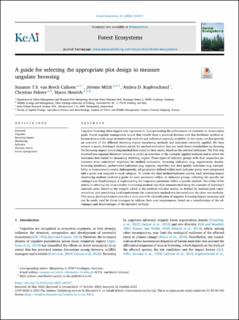| dc.contributor.author | van Beeck Calkoen, Suzzane T S | |
| dc.contributor.author | Milch, Jérôme | |
| dc.contributor.author | Kupferschmid, Andrea D. | |
| dc.contributor.author | Fiderer, Christian | |
| dc.contributor.author | Heurich, Marco Dietmar | |
| dc.date.accessioned | 2024-03-12T12:45:51Z | |
| dc.date.available | 2024-03-12T12:45:51Z | |
| dc.date.created | 2023-12-04T14:45:56Z | |
| dc.date.issued | 2023 | |
| dc.identifier.citation | Forest Ecosystems. 2023, 10 . | en_US |
| dc.identifier.issn | 2197-5620 | |
| dc.identifier.uri | https://hdl.handle.net/11250/3121972 | |
| dc.description.abstract | Ungulate browsing often impairs tree regeneration, thus preventing the achievement of economic or conservation goals. Forest ungulate management would thus benefit from a practical decision tool that facilitates method selection from a wide range of monitoring methods and indicators currently available. In this study, we first provide an overview of the different browsing-impact monitoring methods and indicators currently applied. We then present a newly developed decision matrix for method evaluation that can assist forest stakeholders in choosing the browsing-impact monitoring method best suited to their needs, based on the selected indicators. The first step involved two separate literature reviews to create an overview of the currently applied methods and to select the indicators best suited for measuring browsing impact. Three types of indicator groups with their respective parameters were considered important for method evaluation: browsing indicators (e.g. regeneration density, browsing incidents), performance indicators (e.g. expense, expertise) and data quality indicators (e.g. susceptibility to measurement errors). Subsequently, all parameters defined within each indicator group were categorised and a grade was assigned to each category. To create the final method-indicator matrix, each browsing-impact monitoring method received a grade for each parameter within all indicator groups, reflecting the specific advantages and disadvantages of implementing the respective parameter within a specific method. The utility of the matrix in selecting the most suitable monitoring method was then demonstrated using the example of Germany's national parks. Based on the weights added to the method-indicator matrix, as defined by national park representatives, and considering local requirements the nearest-tree method was favoured over the other two methods. This newly developed matrix provides a more scientific objectification of ungulate browsing-impact measures and can be easily used by forest managers to address their own requirements, based on a consideration of the advantages and disadvantages of the included methods. | en_US |
| dc.language.iso | eng | en_US |
| dc.rights | Attribution-NonCommercial-NoDerivatives 4.0 Internasjonal | * |
| dc.rights.uri | http://creativecommons.org/licenses/by-nc-nd/4.0/deed.no | * |
| dc.subject | ungulate | en_US |
| dc.subject | browsing impact | en_US |
| dc.subject | monitoring | en_US |
| dc.subject | indicator | en_US |
| dc.subject | decision matrix | en_US |
| dc.subject | forest management | en_US |
| dc.title | A guide for selecting the appropriate plot design to measure ungulate browsing | en_US |
| dc.title.alternative | A guide for selecting the appropriate plot design to measure ungulate browsing | en_US |
| dc.type | Peer reviewed | en_US |
| dc.type | Journal article | en_US |
| dc.description.version | publishedVersion | en_US |
| dc.rights.holder | © 2023 The Authors. | en_US |
| dc.subject.nsi | VDP::Landbruks- og Fiskerifag: 900::Landbruksfag: 910::Naturressursforvaltning: 914 | en_US |
| dc.source.pagenumber | 11 | en_US |
| dc.source.volume | 10 | en_US |
| dc.source.journal | Forest Ecosystems | en_US |
| dc.identifier.doi | 10.1016/j.fecs.2023.100147 | |
| dc.identifier.cristin | 2208613 | |
| dc.source.articlenumber | 100147 | en_US |
| cristin.ispublished | true | |
| cristin.fulltext | original | |
| cristin.qualitycode | 1 | |

